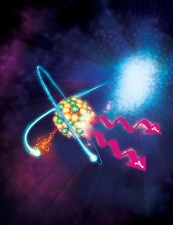Polish scientists co-author an article in "Nature", describing an observation of forced release of energy from excited atomic nuclei
08-02-2018

NEEC artistic vision.
Credits:
James J. Carroll, William Parks,
and Eric Proctor
(U.S. Army Research Laboratory)
For the first time it was experimentally shown that atomic nuclei can be excited by catching an electron on unfilled atomic electron shell. The result can have both theoretical and practical application. The latest issue of Nature magazine reports about the discovery. Co-authors of the work are Polish scientists.
In the latest edition of the journal Nature (February 2018), an article under title "Isomer depletion as experimental evidence of nuclear excitation by electron capture" was published. The authors report the first experimental observation of a new, previously hypothesized physical phenomenon, i.e. the process of nuclear excitation by electron capture in the atom's shell (Nuclear Excitation by Electron Capture, NEEC). This phenomenon was first recorded for the isotope of molybdenum 93Mo. Isometric nuclear state of molybdenum 93mMo accumulates huge energy in relation to the ground state and its half-life is 6.85 hours. As a result of the NEEC process, the isomeric nucleus of 93mMo receives small amount of energy, on the order of 4.85 keV, which results in its transition to another excited state - this time short lived, with a half-life on the order of nanoseconds. It is almost immediately deexcited to the ground state. This way, it releases energy on the order of 2.5 MeV, initially stored in the nuclear isomer of 93mMo, thus energy 500 times greater than it was supplied.
The experiment was conducted in the United States in the linear accelerator ATLAS at the Argonne National Laboratory. Accelerated, high-charged ions (freed from 32 to 36 electrons) of the 93mMo isomer were used, which when passing through a carbon shield, captured electrons in unfilled atom shells. Researchers anticipated that with properly selected conditions, the electron capture would also result in the desired 93mMo nuclear excitation. Deexcitation of the excited state, taking place through the emission of gamma quanta with specific energies, can be already observed experimentally. Theoretical description of the NEEC process scenario occurrence was presented in March 2017 in the work of a team of Polish and American scientists. Two of these scientists, prof. dr hab. Marek Polasik from the Faculty of Chemistry at the Nicolaus Copernicus University in Toruń and dr Jacek Rzadkiewicz from the National Centre for Nuclear Research in Świerk, also participated in the design and implementation of the experiment and the results interpretation. They co-authored the publication in the Nature journal.
"The success of the experiment depended mainly on the appropriate selection of kinetic energy of the isomer ions of 93mMo and their charged state" - explains Dr. Rzadkiewicz. "It was necessary to ensure optimal conditions for providing the isomer with perfectly matched portion of energy."
"The experimental identification of the NEEC process also required coinciding measurements of gamma radiation for transitions between appropriate nuclear states of the 93mMo isotope," adds Professor Polasik. "Our American colleagues used for this purpose the most powerful in the world Gammasphere spectrometer, consisting of 92 germanium detectors arranged in the shape of 16 spherical rings."
The authors of the publication, in addition to the mentioned Polish scientists, are members of a 16-member international scientific team from the USA, Australia, Italy and Russia. The experiment exceptional significance is evident by the fact that teams from around the world have been competing for over 40 years to become the first one to observe a new phenomenon for any nuclear isomer. The result is important not only as a confirmation of theoretical knowledge.
"Observation of the NEEC processes can have a big impact on understanding processes occurring in the Universe," says Professor Polasik. "In particular, it can provide us with knowledge about survival of the isomeric states of various chemical elements in star environment."
"Research on such processes may also be a starting point for applied research" - add dr. Rzadkiewicz. "Their purpose would be e.g. developing a method of controlled release of energy stored in nuclear isomers, which should contribute to the development of new unconventional concepts and ultra-efficient nuclear batteries."




